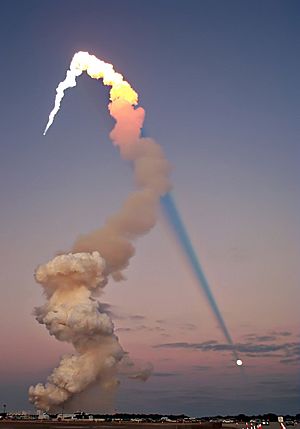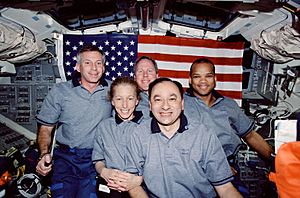STS-98 facts for kids
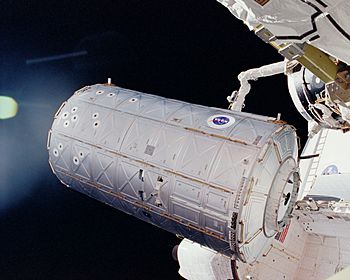
Atlantis' Canadarm grapples Destiny, prior to the module's installation on the ISS
|
|
| Mission type | ISS assembly |
|---|---|
| Operator | NASA |
| Mission duration | 12 days, 21 hours, 21 minutes, 0 seconds |
| Distance travelled | 8,500,000 kilometers (5,300,000 mi) |
| Orbits completed | 171 |
| Spacecraft properties | |
| Spacecraft | Space Shuttle Atlantis |
| Launch mass | 115,529 kilograms (254,698 lb) |
| Landing mass | 90,225 kilograms (198,912 lb) |
| Payload mass | 14,515 kilograms (32,000 lb) |
| Crew | |
| Crew size | 5 |
| Members |
|
| Start of mission | |
| Launch date | 7 February 2001, 23:13 UTC |
| Launch site | Kennedy LC-39A |
| End of mission | |
| Landing date | 20 February 2001, 20:33 UTC |
| Landing site | Edwards Runway 22 |
| Orbital parameters | |
| Reference system | Geocentric |
| Regime | Low Earth |
| Perigee | 365 kilometers (197 nmi) |
| Apogee | 378 kilometers (204 nmi) |
| Inclination | 51.6 degrees |
| Period | 92 minutes |
| Docking with ISS | |
| Docking port | PMA-3 (Unity nadir) |
| Docking date | 9 February 2001, 16:51 UTC |
| Undocking date | 16 February 2001, 14:05 UTC |
| Time docked | 6 days, 21 hours, 14 minutes |
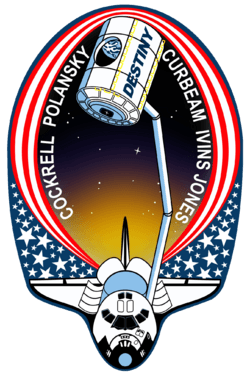 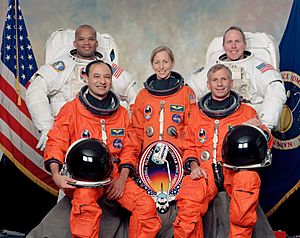 L-R: Robert Curbeam, Mark Polansky, Marsha Ivins, Kenneth Cockrell and Thomas Jones |
|
STS-98 was a Space Shuttle mission that took place in 2001. The mission used the Space Shuttle Atlantis to fly to the International Space Station (ISS). This flight was special because it was the first time humans went into space in the 21st century!
The main goal of STS-98 was to deliver the Destiny Laboratory Module to the space station. This module is a very important part of the ISS. The mission went perfectly. The shuttle landed safely at Edwards Air Force Base on February 20, 2001. The whole trip lasted twelve days, with six of those days spent connected to the ISS.
Contents
Meet the Crew of STS-98
The STS-98 mission had a crew of five brave astronauts. They were responsible for flying the Space Shuttle Atlantis and adding the new laboratory to the International Space Station.
| Position | Astronaut | |
|---|---|---|
| Commander | Kenneth D. Cockrell Fourth spaceflight |
|
| Pilot | Mark L. Polansky First spaceflight |
|
| Mission Specialist 1 | Robert L. Curbeam Second spaceflight |
|
| Mission Specialist 2 | Marsha S. Ivins Fifth and last spaceflight |
|
| Mission Specialist 3 | Thomas D. Jones Fourth and last spaceflight |
|
Launch Day Details
The launch of STS-98 was planned carefully. Sometimes, launches need to be delayed for safety or technical reasons.
| Attempt | Planned | Result | Turnaround | Reason | Decision point | Weather go (%) | Notes |
|---|---|---|---|---|---|---|---|
| 1 | 19 Jan 2001, 2:10:42 am | scrubbed | — | technical | 15 Jan 2001, 3:00 pm | rollback to VAB for booster separation cable inspection | |
| 2 | 7 Feb 2001, 6:11:16 pm | success | 19 days, 16 hours, 1 minute | 90% |
Mission Highlights: Building the ISS

The main goal of STS-98 was to continue building the International Space Station. The crew brought the U.S. Destiny Laboratory Module to the station. This was the first lab from NASA to be used permanently in space since the Skylab station almost 30 years before!
The Destiny module was built by Boeing. It is 28 feet (8.5 m) long and 14 feet (4.3 m) wide. It is made from strong materials like stainless steel and aluminum. The module has three round sections and two end parts with doors for astronauts to go in and out. The ends are colored blue and white to help the crew know where they are. There is also a 20-inch (510 mm)-diameter window on one side.
During the mission, the shuttle connected to a part of the ISS called PMA 3. The crew then used the shuttle's robotic arm to move the 14.5-ton Destiny module out of the shuttle's cargo bay. They then attached it permanently to the front of the Node 1 section of the ISS.
Astronauts Thomas Jones and Robert Curbeam performed spacewalks to connect electrical cables to Destiny. They also checked the lab's window. Another part, PMA 2, was moved to the front of the Destiny module.
The Space Shuttle stayed connected to the ISS for six days. During this time, the lab was attached, and three spacewalks were done to finish putting it together. This mission also marked the 100th spacewalk in U.S. spaceflight history! The STS-98 mission happened while the first crew was living on the new space station.
Spacewalks: Working Outside in Space
Spacewalks, also known as Extravehicular Activities (EVAs), are when astronauts leave their spacecraft to work in space. On STS-98, astronauts Thomas Jones and Robert Curbeam performed three important spacewalks.
| EVA | Spacewalkers | Start (UTC) | End | Duration |
|---|---|---|---|---|
| EVA 1 | Thomas D. Jones Robert L. Curbeam |
10 February 2001 15:50 |
10 February 2001 23:24 |
7 hours 34 minutes |
| Jones and Curbeam worked in the Atlantis cargo bay. They disconnected cables and removed covers from the Destiny module's outside door. After Destiny was installed, they connected power and data cables. | ||||
| EVA 2 | Jones Curbeam |
12 February 2001 15:59 |
12 February 2001 22:49 |
6 hours 50 minutes |
| The astronauts helped move the Pressurized Mating Adapter 2 (PMA-2) from one part of the station to the front of the Destiny lab. They also installed a special fixture for the Canadarm2 robotic arm. | ||||
| EVA 3 | Jones Curbeam |
14 February 2001 14:48 |
14 February 2001 20:13 |
5 hours 25 minutes |
| In their last spacewalk, Jones and Curbeam attached a spare antenna to the ISS. They checked connections on the Destiny lab and released a cooling radiator. They also practiced carrying an astronaut who might be unable to move. | ||||
Wake-up Calls: Music in Space
NASA has a fun tradition of playing music to wake up astronauts. This started during the Gemini program. Each song is chosen carefully, often by the astronauts' families. The songs usually have a special meaning to one of the crew members or relate to their daily tasks.
| Flight Day | Song | Artist/Composer | Links |
|---|---|---|---|
| Day 2 | "Where You At" | Zoot Sims | [] |
| Day 3 | "Who Let the Dogs Out" | Baha Men | [] |
| Day 4 | "Girl's Breakdown" | Alison Brown | [] |
| Day 5 | "Blue Danube Waltz" | Johann Strauss Jr. | [] |
| Day 6 | "Fly Me to the Moon" | Frank Sinatra | [] |
| Day 7 | "For Those About to Rock" | AC/DC | [] |
| Day 8 | "To the Moon and Back" | Savage Garden | [] |
| Day 10 | "The Trail We Blaze" | Elton John | [] |
| Day 11 | "Blue (Da Ba Dee)" | Eiffel 65 | [] |
| Day 12 | "Fly Away" | Lenny Kravitz | [] |
| Day 14 | "Should I Stay or Should I Go" | The Clash | [] |
See also
 In Spanish: STS-98 para niños
In Spanish: STS-98 para niños


